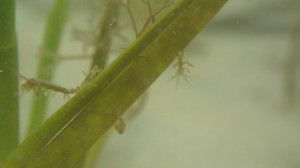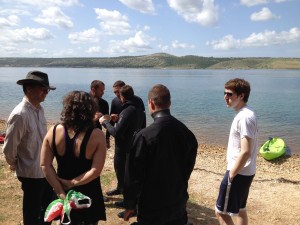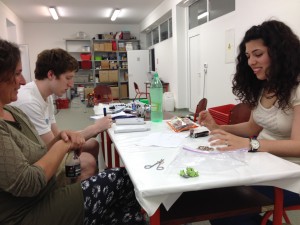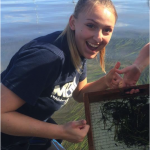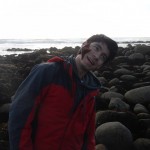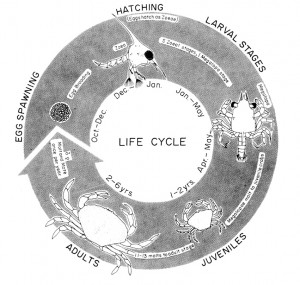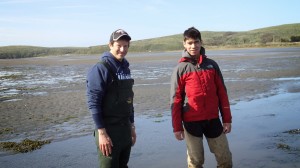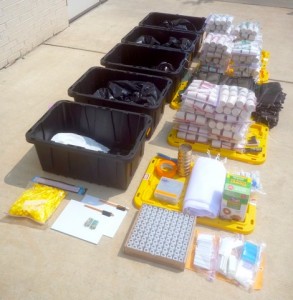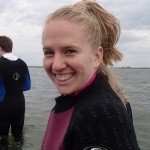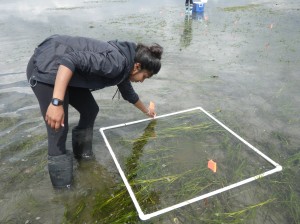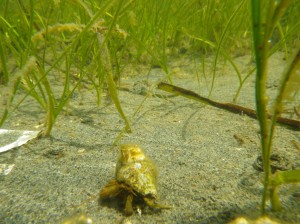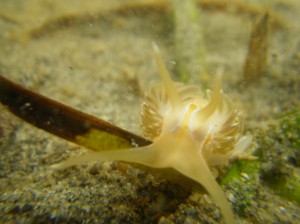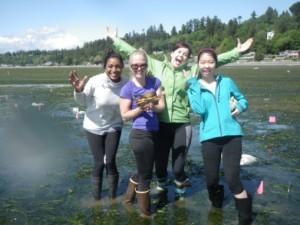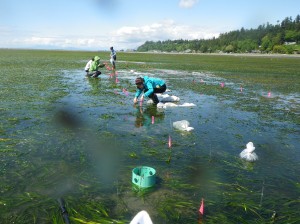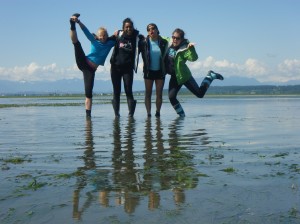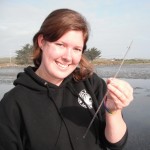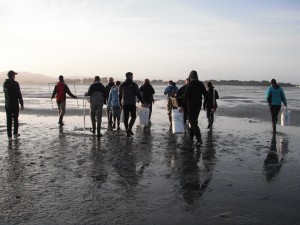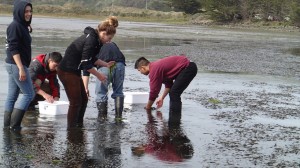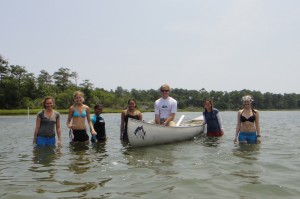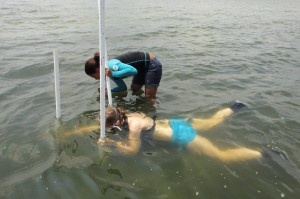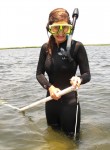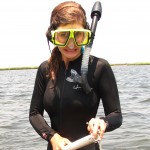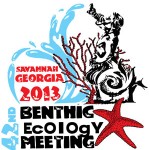A close look at a seagrass creature – caprellids
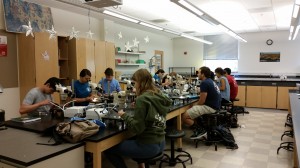
Students in the UC Davis ZEN class sort specimens of mesograzers – small invertebrates that live in seagrass beds
by Elena Huynh (undergraduate in the UC Davis ZEN class)
My first look under the dissecting microscope at a caprellid amphipod was alarming, to say the least. Enormous Claw-like mouthparts and red eyes stared straight back at me and I jumped back in my seat. Lucky for me, no one was there to observe my visceral reaction to this strange looking animal. After taking a moment, I knew that I would need to get comfortable looking at these odd creatures since we would be performing lots of species identifications during the course of the ZEN class at UCD, so I gave it another look under the scope. Despite the permanent menacing stare, this caprellid was not so scary, albeit a bit bizarre. I noticed a deadly looking spike behind its head and paused before learning that this protuberance is a defining characteristic of this caprellid species—Caprella californica!
After observing this caprellid’s scythe-like claws, I wondered what they were used for. As it turns out, caprellids are pretty clingy. They use their claws (gnathopods) and their legs (pereopods) to hang onto seagrass leaves and algae as they either graze the epiphytes that grow on top of the leaves or filter particles out of the water. Some caprellids can actually help seagrasses grow by cleaning the seagrass leaves and increasing their light exposure, increasing their growth. I guess caprellids would make good housekeepers, since they’re constantly cleaning off dirty surfaces.
Out in the field, I had the opportunity to watch caprellids swim. I wondered how these stick figures managed to get around. Through close observation, I noticed that they do a lot of crawling – which makes sense because they don’t appear to have pronounced flippers or large paddles. When they are not clinging to a surface or crawling they get around by moving like a wave. They curl up their bodies then push their feet and head back at the same time, over and over. It is pretty surprising to see what they manage to do with a body plan I’d consider adverse to swimming.
After doing a little research, I found out that some caprellids have hairs on their antennae – called swimming setae – that help them get around (Caine 1979). Although some can swim, they don’t swim very well nor do they swim for very long. If they’re living in beds of seagrass, all they would really need to be able to do is to hop to get from leaf to leaf. Learning more about what caprellids do for a living has helped me appreciate them, and they just might now be my favorite inhabitants of seagrass beds!
For more information, check out: Caine E.A. Functions of Swimming Setae within Caprellid Amphipods (Crustacea). 1979. Biological Bulletin 156:169-178.
“Bok” from Croatia!
by Austin Ruhf (College of William and Mary undergraduate, ZENtern)
Bok, or hello, from Croatia! I’m one of the ZENterns from the College of William and Mary and am spending my summer with classmate Dave Godschalk assisting with the ZEN research in beautiful Zadar, Croatia. I have only been at my host site for a week, but so far Croatia has been a welcoming and easy going paradise. Despite a comical amount of initial bureaucracy (it seemed like we needed the equivalent of a social security registration to gain internet access), the locals have been more than accommodating towards my ignorant American self. My host supervisor at the University of Zadar, Dr. Claudia Kruschel, has been fantastic to work with. She seems to never grow tired and goes out of her way to make sure that all of our work is a group effort. She even lent me her daughter’s guitar so I wouldn’t get musical withdrawal during my stay abroad!
The only downside is that the ZEN field sites are subtidal and are so deep that they have to be surveyed by professional divers. This means that the bulk of my and Dave’s work is done in the lab. The facilities are setup differently from the lab back at VIMS, but the work itself is similar. After a strenuous first week, we have settled into a manageable schedule.
Outside of the lab, fellow intern Dave and I have begun to explore Zadar in our spare time. Dave is already hooked on espresso and sparkling water, and I’m trying to discover more about the culture of the young people here. This led me to watch a heavy metal music show in an old puppet theater, which was pretty strange but somehow felt completely natural. We next hope to visit a few of the world-famous beaches here in Croatia, and learn how to best avoid the crowds of German tourists. Who knew that this was such a popular spot for science, and for a holiday?
A buoyant day in the field
by Whitney Dailey (San Diego State University undergraduate, ZENtern)
One of my favorite parts of the ZEN seagrass ecosystem ecology course at San Diego State University this past spring semester was working in the field and learning about seagrass ecology through a hands on approach.
One field day that I will never forget was when we were collecting our predation intensity experiment. The experiment consists of deploying several “tethers”, which are made by gluing grazers (in this case small grass shrimp or snails) to fishing line placed out in the seagrass bed. We then come back later to record whether the animals have been eaten. The purpose of the experiment is to understand the level of predation in the environment and the relatively susceptibility of different types of grazers.
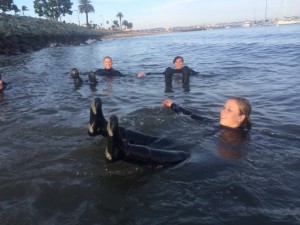
Whitney and classmates at SDSU learn the importance of being prepared for the unexpected – and in bringing weight belts out into the field
However, one of the main lessons that we learned during our time in the field with the ZEN class is that every experiment has its own challenges and the trick is to problem solve and find a way around it. On this particular field day we met the challenge of trying to schedule fieldwork around both our class schedule and the tide. For us this meant struggling to find the tethers in around 3 to 4 feet (1-1.5 meters) of water. While this may not sound challenging, we found it to be very difficult. We would try to dive down, but the extra buoyancy from our wetsuits at that shallow depth made us pop up to the surface right away. So, we just floated on the surface and would reach down and try to find them and pull them out. The trick was not giving up, and remembering to bring a weight belt in the future.
After many failed attempts of trying to retrieve the tethers, we were finally able to hold onto the pieces of rebar we’d installed to mark our experimental plots, and feel around until we found the tether and pulled it out. Every time we found a tether we would get so excited – until we moved on to retrieve the next one. But, with a lot of commitment and perseverance we completed our field day at our ZEN site in San Diego Bay and learned new methods for problem solving during fieldwork. We also learned that in marine ecology (and likely the other sciences) the truly exciting part comes from overcoming challenges, even the ones you didn’t anticipate!
Whitney graduated summa cum laude this May from San Diego State University, receiving her Bachelors of Science in Biology and Environmental Science. She has been working in seagrass ecology as part of Dr. Kevin Hovel’s lab for the past four years including on the initial ZEN projects in 2011-2012. Hailing from Washington, Whitney enjoys playing basketball and taking photographs in her spare time. This fall she plans to being a job as a research technician before applying to graduate school. Whitney will be traveling to work with Dr. Per-Olav Moksnes and his research group in Sweden as par of her ZENternship this summer.
A closer look at an eelgrass inhabitant – the Dungeness crab
by Jason Toy (Undergraduate student in the UCD ZEN class)
Several weeks ago, I was out at Bodega Bay with my classmates from the UCD ZEN course collecting field data for our research projects. As I stood out there in the water in my borrowed waders, I observed quite a few different species of invertebrates as they made their way through the bed of eelgrass. Most were quite familiar to me at that point, but there were a few species, including the Dungeness crab, Cancer magister, that I had not thought of as typical eelgrass inhabitants. I decided to do a little research on the life history of these crustaceans in order to better understand the importance of estuarine seagrass beds to this – and potentially other – important crustacean species.
I was surprised to learn that these crabs move around quite a bit during their life histories. Adults mate in nearshore coastal locations in the Pacific Northwest throughout the spring (Pauley et al., 1989), a process in which the male embraces the female for up to 7 days before she molts, after which the actual transfer of sperm occurs. She stores this sperm for about a month until she extrudes her eggs and, in the process of doing so, they are fertilized (Tasto et al., 1893). But her care doesn’t end there. She protects her eggs by storing them on her abdomen for several months until winter (typically December – January). Then one day, these 1-2 million eggs hatch and the baby crabs leave their mother and enter a 105-125 day planktonic larval period. During this time the young Dungeness crab goes through many developmental changes, moving through 5 zoeal and 1 megalopal stages. After reaching the megalopa stage, the young crabs settle out onto the bottoms of bays and estuaries, where they molt into their first juvenile crab stage and begin to actually resemble real crabs.

During field sampling, Jason and classmates found a few juvenile Dungeness crabs hiding amid the eelgrass in Bodega Bay, California
This is where seagrass comes in! Coastal estuaries (like Bodega Harbor) play a critical role for juvenile Dungeness crabs as a nursery. Large numbers of juvenile crabs benefit from the protection and substrate provided by beds of eelgrass (Zostera marina). They cling to and hide within the grass, consuming other small organisms within the habitat (amphipods, isopods, polychaetes, essentially whatever they can catch!) (Pauley et al., 1989). After several molts, subadults and adult Dungeness crabs begin to leave the eelgrass beds and move offshore, but a few do remain in inland coastal waters, hiding among the eelgrass blades.
The role of seagrass beds in the life history of Dungeness crabs is an important interaction to talk about because it is an example of an economic benefit (known as an ecosystem service) provided by seagrass beds. Seagrasses are critical species in coastal environments around the globe, as they form habitat structure and promote a large diversity of organisms. However, like the coral reefs, they are currently in decline due to the effects of human activities. The connection of an economically important species such as Cancer magister to these seagrass ecosystems, however, can help bring attention to this issue, and provide an incentive for the preservation and restoration of this habitat. Help spread the word!
For more information, check out these references:
Pauley, G. B., Armstrong, D. A., Citter, R. V., & Thomas, G. L. (1989). Species Profiles: Life Histories and Environmental Requirements of Coastal Fishes and Invertebrates (Pacific Southwest): Dungeness Crab. U.S. Fish and Wildlife Services Biological Report 82(11.121): 7-8.
Tasto, R. N., & Wild, P. W. (1983) Life History, Environment, and Mariculture Studies of the Dungeness Crab, Cancer Magister, With Emphasis on The Central California Fishery Resource. California Department of Fish and Game Fish Bulletin 172, 319-320. Retrieved June 11, 2014, from http://content.cdlib.org/view?docId=kt1k4001gs&&doc.view=entire_text
Jason is an aspiring marine ecologist with a passion for all things science. He is a rising senior at UC Davis studying evolution and ecology. His dream job is to be a research SCUBA diver. This summer he will be working in Dr. Jay Stachowicz’s marine ecology lab at UC Davis’ Bodega Marine Laboratory.
Thowback Thursday – Setting the Stage
Working with a large, global network of collaborators poses unique opportunities — as well as challenges. Before ZEN’s parallel experiments could start at the 15 widely scattered partner sites in 2011, the VIMS team had to purchase, fabricate, assemble, package, and ship the experimental materials to the sites located throughout the northern hemisphere. That summer we shipped out up to 6 crates and over 500 lbs of gear per site (that’s almost 3.8 tons total!). There was a lot to be done before we could pull on the dive booties and plunge into the water at our own site! For summer of 2014 the focus is on rigorous, controlled surveys and smaller scale experiments, which has the added benefit of less international shipping!
Tsawwassen – home to big isopods, eelgrass and crabs
by Danielle Hall (College of William & Mary undergraduate student, ZENtern)
After three days of intense lab preparation and field work, the first ZEN2 site has been completed!
I arrived in British Columbia late on May 15th and the next day we got straight to work. After prepping materials in the lab we hopped in the lab truck and headed to our field site in a town outside of Vancouver called Tsawwassen. This particular site is in an intertidal zone and we chose to work on the lowest tide of the year since, during any other time, the site would be submerged and difficult to access.
To get to the site we climbed down over two hundred steps. Next, in our fashionable rubber boots, we hiked our way through the mud to get to our site (a treacherous task since the mud had a habit of clinging to our boots). On more than one occasion help was required to extricate a sunken foot.
I was amazed at the size of the Zostera shoots. They were nearly twice the size of the eelgrass in my home field site in Virginia! Not only were the shoots large, but the isopods were comparatively gigantic as well.
I was joining on day two of the field work and so the 20 experimental plots were already marked with orange flags. On this day, our job was to deploy the predation assay. The purpose of this assay is to understand the relative predation rates across the different ZEN site. The experimental units, or ‘PTUs,’ consist of a piece of bait tethered to an acrylic rod. The baits ranged from local animals, like the giant isopods, to a standard control, a piece of cut dried squid. A PVC quadrat helped visualize where to place our PTUs.
Having spent several summers helping deploy previous ZEN projects in the Chesapeake Bay, I was very curious to discover the differences in eelgrass beds between the two coasts. Here, anemones abounded right on the eelgrass shoots. I was amazed that they were able to make a living on plant tissue since in all my past experiences I had only ever seen anemones attached to a hard substrate (There are anemones living in eelgrass beds in the Chesapeake Bay as well, but they are generally small and scarce.)
Our lab group got particularly excited about a pair of nudibranchs who then became the stars of a Hollywood-esque photoshoot. Meanwhile a bald eagle joined us for a bit, clearly finding a tasty meal within the seagrass.
Our second day in the field was filled with surprises. After recording the results of the predation assay (the bait was either gone – eaten, presumably – or present), we continued with collecting samples. After combing through the plots at least two times, Celine – another ZEN participant – uncovered quite a surprise: a huge Dungeness crab hiding in the mud! And he was not too happy that we were intruding in his home. One of the other women, Jemma, mustered up the guts to pick up the feisty crab, and we all gathered around to take a picture with our new friend.
Day two was a long afternoon of working in our plots. So long in fact that the tide decided to turn despite the fact that we still had half our plots to process. A race ensued. We were optimistic. The tide was persistent. We lost. I was in the process of taking sediment core samples when I noticed the tide line getting ever so close, though I was determined to finish. When I peeked over my shoulder, I decided I could finish three more plots. I didn’t even finish the one I was on. Soon water was rushing into our site.
I abandoned my own task to help others finish collecting algae. We developed an effective method of the two hand scoop, where we quickly ran both hands through the plot to work like a sieve. Soon the water engulfed our boots which was followed by multiple exclamations, but together we finished all the plots. Looking towards the shore, our samples and coolers were being carried by the tide. It took all our effort to traverse back to the shore, and on the way retrieve the heavy, runaway samples.
Danielle is a rising senior at the College of William and Mary. As a ZENtern she will be working with the lab of Dr. Mary O’Connor at the University of British Columbia in Vancouver, as well as back at the Virginia Institute of Marine Science with Dr. Emmett Duffy’s Marine Biodiversity Lab during summer 2014. She has been volunteering in Dr. Duffy’s lab for the past two years and is from Massachusetts. Aside from her passion for science, Danielle is an avid dancer.
Science boot-camp at the Bodega Marine Lab
by Julie Blaze (UC Davis undergraduate, ZENtern)
Marine biologists don’t often find themselves trekking through dense remote jungles or climbing desolate mountains to conduct their research. Some would say we’ve got it pretty easy – the ocean covers around 70% of the earth’s surface, and studying biodiversity can be as easy as walking out to the coast and digging in the sand. The only downside to the job is that we are captives to the ebb and flow of the tides. My classmates and I in the ZEN class at UCD found that out the hard way when we took a field trip to the Bodega Marine Laboratory to survey the eelgrass growing in Bodega Harbor.
As someone who enjoys sleep, I can honestly say it is difficult to wake up at 5:30 am for any reason. Awake before the sun and trudging across the mud flats before its first rays had even reached the water, I know I wasn’t the only one thinking of the warm, comfy beds we had left behind. My boots were a little too big and kept getting stuck in the mud – I almost went sprawling face down into the mud more than once. As the sun rose, I wondered what we must have looked like to anyone watching from the shore – a zombie-like group of college students floundering in the mud. Slowly we gained more energy and set about surveying a large expanse of the seagrass bed collecting samples and taking measurements. We worked efficiently and conversation picked up as excitement and adrenaline grew with each new discovery and lapping reminder of the incoming tide. At first glance the mudflats and seagrass meadows look barren, but we quickly found that they teemed with life. Critters clung to the grass or buried themselves in the mud – making this eelgrass bed, similar to other seagrass meadows, one of the most diverse ecosystems in the ocean.
After a few hours the water had crept too high for us to work and we headed back to the lab to begin processing our samples. We put in a long day, getting as much done as we could before calling it quits. We all found those cozy beds soon after a late dinner, with the promise of another early field day tomorrow.
The next morning we again rose before the sun and stumbled out into the mud. But this time we were more familiar with the science – the methodology and how to work as a team – and we finished before the water chased us out.
By the end of the weekend I was thoroughly exhausted, but I didn’t care. We had spent an incredible weekend having an amazing adventure. Not only did I learn about the animals and ecosystem we were exploring, but I also learned several things about myself that weekend. First, I learned that I am willing and able to wake up before the sun to do research. Second, not even the wilds of a remote jungle can tempt me away from the mysteries of the ocean. And, finally, one lesson I will never forget – it’s easy to stay awake once your boots flood with freezing cold seawater. But, it’s even easier when you’re also out exploring a location as interesting as a Bodega Bay seagrass bed!
Julie is a graduating senior at UC Davis majoring in Biology. This summer she will be a ZENtern working with Dr. Nessa O’Connor in Ireland. Julie is a true team player and earned the nickname “den mother” during the 3-day, marathon class field trip and subsequent weeks of sample processing back on campus.
Photos contributed by Aaron Goodman.
A swim down memory lane
by Pamela Reynolds (ZEN coordinator)
The past several months we’ve been entrenched in finishing processing the experimental samples, analyzing data and writing up the results. This is a big switch from our constantly on the go routine during field season, and gives us time to reflect on what an amazing past two years we’ve had with ZEN. In that vein, I’ve dug up two pre-blog posts, quick little snippets I wrote back in the summer of 2011 before we launched the ZENscience.org website.
August 2011: Fieldwork Happens
Out in the field, the one thing I dread most isn’t encountering sharks in the murky water, seeing lightning streak overhead, or being pursued by voracious horseflies. Nope – it’s Murphy’s Law. We’ve all experienced it. A perfectly planned experimental setup can go from a well rehearsed orchestra to utter cacophony in a split second simply because someone forgot to bring scissors or dropped the ruler overboard, or a rogue wave made off with a pencil.
In our case, after placing and pounding 320 poles in the water we realized that our once lovely Zostera bed is now overgrown with Ruppia, a different type of seagrass. In our defense, the seagrass in the clearer water near the approach to the site was, in fact, Zostera. Murphy rears his ugly head, once again. How to deal with the mishap? Remove the poles, all 320 of them, call a few colleagues to find a new site, borrow a boat, and start over. This time everyone knew the drill and the setup went exceedingly smoothly. And, in the process we all learned how to distinguish the three local types of seagrass (Zostera, Ruppia, Halodule) by touch alone in the murky water. Turning Murphy into an educational experience – now that’s science! Having a team of graduate and undergraduate students who keep smiling? Priceless.
[Update: While I still despise coming up short on cable ties in the field, getting caught out on the water during a thunderstorm has quickly risen to fear #1. See the "Science is electric" blog post from 2012 to find out why.]
April 2011: When it absolutely, positively has to be there overnight
In preparing for ZEN the VIMS team became well versed in navigating international shipping. One of the things we learned early on was that customs agents are often quite literal. For instance, “300 blocks of 120 mL hardened dental plaster” can be translated into medical equipment and is subject to high tariffs. Doesn’t matter that the plaster has already been hardened and can’t be used to make casts of someone’s teeth – it’s all in the product description. And being vague isn’t much help either. Some countries want to know the composite materials of a t-shirt or line items of every ingredient in the dog food we used as fish bait, while for others the phrase “for education/research, not for resale” is sufficient. We are expecting that to some extent each country will have unique mesograzer assemblages and ecological interactions – why should we assume their import/export process to be the same?
[Update: I wrote this after a week of playing phone tag and emailing with shipping and customs agents to get our packages cleared and on their way to our international partners. Ultimately everything went through and there were no major delays or disruption of our partners' field schedules. Lesson learned? Leave at least a 3 week shipping allowance for international projects. And, keep UPS on speed dial!]
I’m a GRAZER baby…
by Pamela Reynolds (ZEN Coordinator)
As a small token of our appreciation for the hard work of all of the ZEN partners (past, present and future!), we present:
“GRAZER”. Turn up the volume and enjoy!
This film is, as everything in ZEN, a collaborative production and we very much appreciate the contributions of all of the ZEN participants. Lyrics were written by Paul Richardson, editing by undergraduate Conor MacDonnell, and lyrics by undergraduate Nick Penthorne. The film features cameos by Emmett Duffy and others in the Marine Biodiversity Lab at VIMS, as well as chorus refrains from many of the ZEN sites (watch the film all the way to the end so you don’t miss this!). The film premiered along with a select few other films on the big screen at the Beneath the Waves Film Festival at the Benthic Ecology Meeting last week in Savannah, GA. Enjoy!
GRAZER debuts at Beneath the Waves Film Festival
by Pamela Reynolds (ZEN Coordinator)
At the Virginia Institute of Science, we are gearing up for this year’s Benthic Ecology Meeting in Savannah, Georgia. We can’t wait to hear what our colleagues are up to, talk science, and watch the films at this year’s Beneath the Waves Film Festival.
Come to the festival on the evening of March 21st to watch our short film, titled “GRAZER”. This film was produced by the Marine Biodiversity Lab at VIMS and features contributions from the ZEN partners as well as undergraduates at the College of William and Mary. It’s our way of saying “thank you” to all of the hard working individuals who’ve dedicated the past two years with us to quantify the role of biodiversity and to understand top-down and bottom-up interactions in eelgrass beds. We’ll be posting the full video on ZENscience.org later this week, so check back!
To get you excited, here’s a short teaser…

